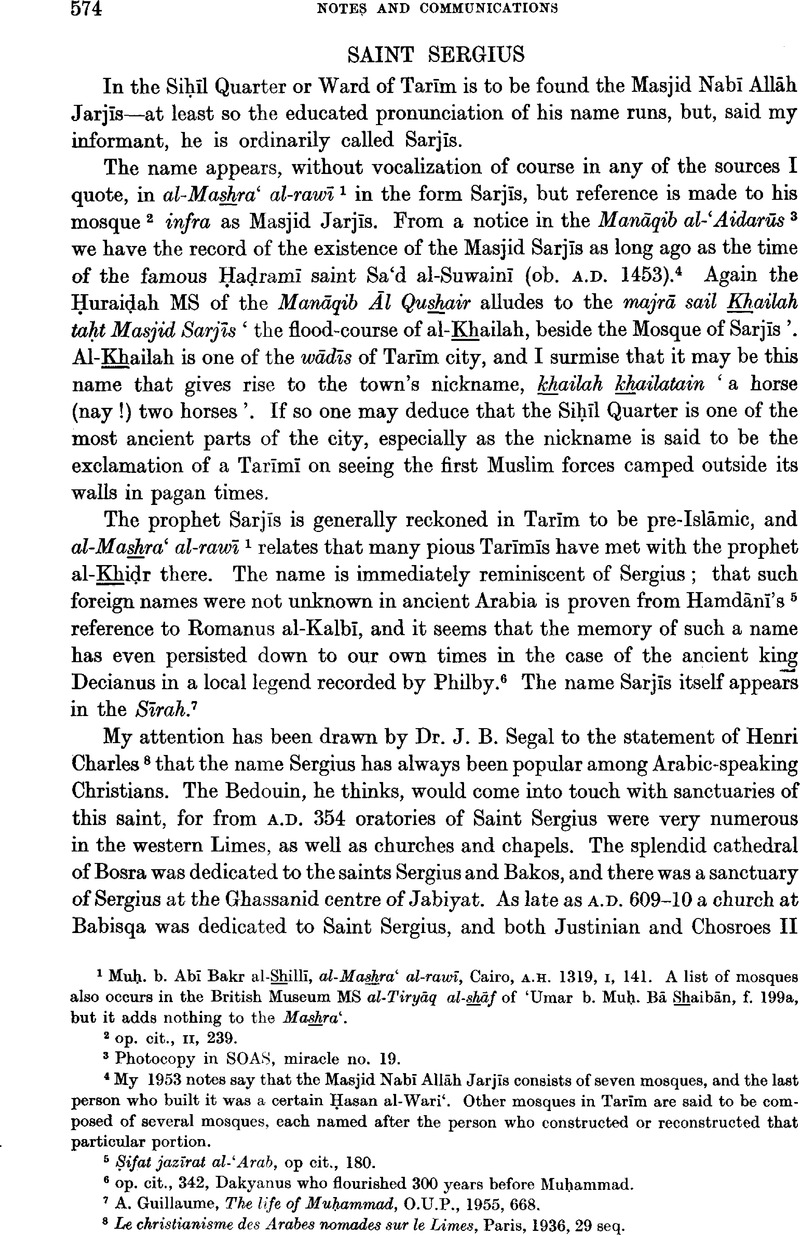Article contents
Abstract

- Type
- Notes and Communications
- Information
- Bulletin of the School of Oriental and African Studies , Volume 22 , Issue 3 , October 1959 , pp. 574 - 576
- Copyright
- Copyright © School of Oriental and African Studies, University of London 1959
References
page 574 note 1 Muḥ. b. Abī Bakr al-Shillī, al-Mashra‘ al-rawī, Cairo, A.H. 1319, I, 141. A list of mosques also occurs in the British Museum MS al-Tiryāq ![]() of 'Umar b. Muḥ. Bā
of 'Umar b. Muḥ. Bā ![]() , f. 199a, but it adds nothing to the Mashra‘.
, f. 199a, but it adds nothing to the Mashra‘.
page 574 note 2 op. cit., II, 239.Google Scholar
page 574 note 3 Photocopy in SOAS, miracle no. 19.
page 574 note 4 My 1953 notes say that the Masjid Nabi Allāh Jarjis consists of seven mosques, and the last person who built it was a certain Ḥasan al-Wari'. Other mosques in Tarīm are said to be composed of several mosques, each named after the person who constructed or reconstructed that particular portion.
page 574 note 5 Ṣifat jazīrat al-'Arab, op cit., 180.
page 574 note 6 op. cit., 342, Dakyanus who flourished 300 years before Muhammad.
page 574 note 7 Guillaume, A., The life of Muḥammad, O.U.P., 1955, 668.Google Scholar
page 574 note 8 Le christianisme des Arabes nomades sur le Limes, Paris, 1936, 29 seq.Google Scholar
page 575 note 1 Wright, William, Catalogue of the Ethiopic manuscripts in the British Museum, London, 1877, p. 160.Google Scholar
page 575 note 2 Ed. Axel Moberg, Lund, 1924, p. cix, MS f. 14b.
page 575 note 3 It is interesting to remark that there were also presbyters from Ḥīrah and Abyssinia.
page 575 note 4 op. cit., p. cxvi, MS f. 24b.
page 575 note 5 Beckingham, C. F. and Serjeant, R. B., ‘A journey by two Jesuits from Dhufār to Ṣan ‘ā’ in 1590’, Geog. Jour., cxv, 4–5, 1950, 197.Google Scholar
page 575 note 6 Lyall, C. J., Commentary on ten ancient Arabic poems, Calcutta, 1894, Ar. text p. 26. Aw maṣābīḥu rāhibin ahāna 'l-salīṭa bi-'l- dhubāli 'l-mufattali ![]() . Salīt is said to be Yemenite for sesameoil by the lexicons—which is still true to-day; both the other words are used commonly for 'wick', though one says fatīlah and not mufattal.Google Scholar
. Salīt is said to be Yemenite for sesameoil by the lexicons—which is still true to-day; both the other words are used commonly for 'wick', though one says fatīlah and not mufattal.Google Scholar
page 575 note 7 Ibn al-Mujāwir, Tārikh al-Mustabṣir, ed. O. Löfgren, Leiden, –, 209. The population consisted of Jews, Christians, and Muslims, each religion constituting one-third of the population, but Ibn al-Mujāwir does not reveal whether this is contemporary observation or merely quotation from earlier sources. A survival of the Christian community into the Middle Ages is a little unexpected, but the Jewish community, as can be ascertained from Philby, loc. cit., survived up till its final exodus a few years ago.
- 2
- Cited by




